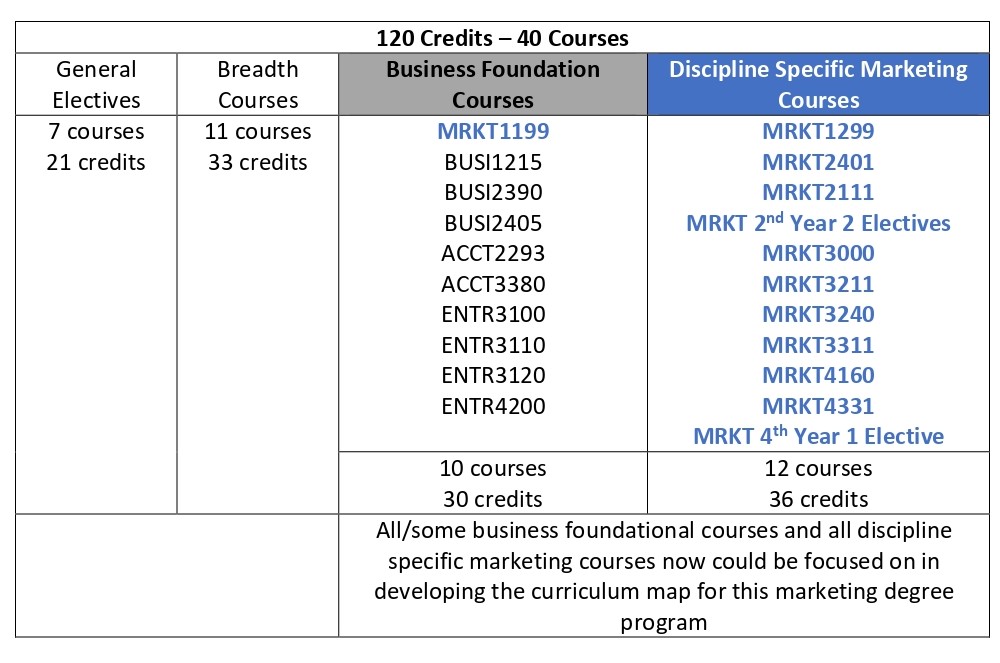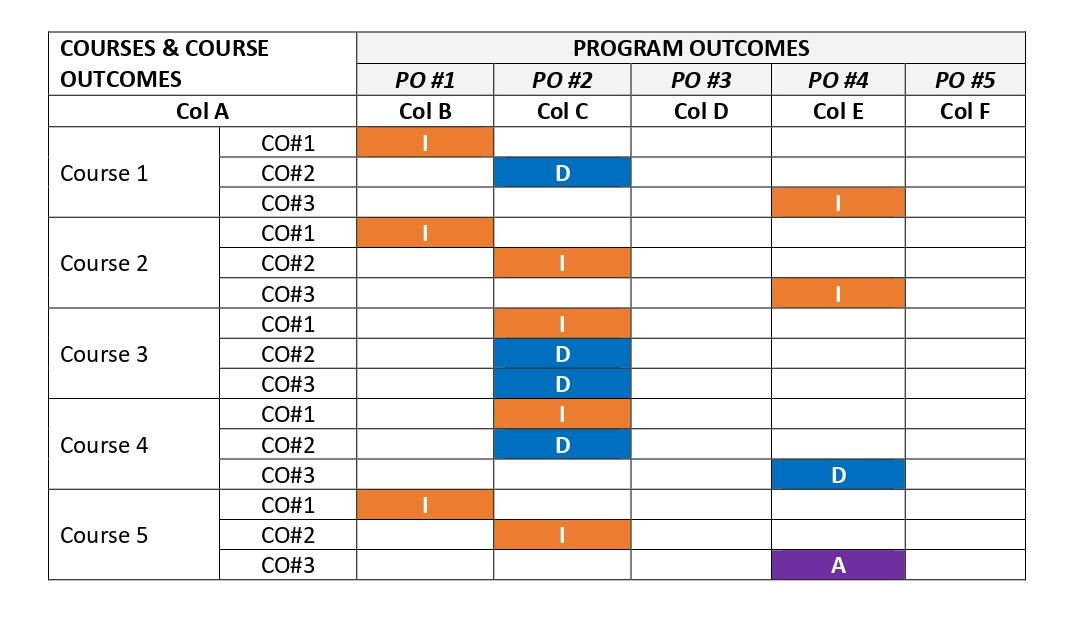3.6. Curriculum Mapping
In this section, the program review team will be directed to map out the program outcomes developed/updated in section 3.4 against all course level learning outcomes. To fulfil this requirement, the team will be required to complete a curriculum map.
After completing this section, the program review team may identify potential gaps in the current curriculum map. If gaps are identified, they need to be addressed in the recommendations section of the self-study report.
What is Curriculum Mapping
Curriculum mapping is the process of associating and aligning course level outcomes (CLO) with program level outcomes (PLO) to ensure that the program is structured in a strategic, thoughtful way that enhances student learning (Harden, 2001).
In other words, a curriculum map would help the program review team to identify how the program level learning outcomes are represented or addressed through courses and course level outcomes of that program. The curriculum map resembles a matrix (rows by Columns) more than a traditional map (Grant & Kalu, 2019)
Difference between Program and Course Level Outcomes
PLOs are designed to deliver knowledge, skills, and attributes that students are expected to attain by the end of a program of study. They highlight how skills; competencies are delivered to students in broad yet in a measurable manner.
Courses are the building blocks of programs and the outcomes allow us to scaffold learning to build competency over time of the program. Course level outcomes are more specific, actionable than program level learning outcomes.
For example, a Program Learning Outcome (PLO) might be:
- Students will be expected to write a research paper that is informed by academic literature in the field.
The above statement is broad and needs to be articulated in more specific, measurable ways at the course level. Here are some examples of potential Course Outcomes (CLO) that map directly back to the PLO, though there could be many others:
- Students will be expected to find appropriate academic articles to inform their written work.
- Students will be expected to evaluate the suitability of specific academic articles that inform their written work.
- Students will be expected to write a clear, concise research paper that relates to the course concepts
- Students will be expected to use APA in their citations, references, and paper formatting.
Source: Dyjur, Grant, & Kalu, 2019. University of Calgary, Taylor Institute, Program-Level Learning Outcomes
Developing a curriculum map involves several steps and often it is a complex process. Here are some tips to build a curriculum map step-by-step.
3.6.1 Identify Courses & Course Outcomes to Include in the Map
A typical 4-year degree program includes 120-credit credits distributed across 40 individual courses (3 credits x 40). Mapping multiple course outcomes across 40 courses would become quite complex. Not all courses offered in the program are discipline specific or foundational. For example, many programs offered at KPU includes several breadth education and general electives that are outside the core discipline specific courses. Go through the current program and identify discipline specific courses (core and electives), breadth and general electives. Identify course codes, course labels and the assigned credits of these courses.
Here is an example from the Bachelor of Marketing Management Degree

3.6.2 Develop the Curriculum Map
Refer to the example, template below as you follow these steps.
Appendix 7: Curriculum Mapping Template
Step 1 – In Column B… horizontally, list all the program outcomes developed/revised in section 3.4
Step 2 – In Column A vertically, list all discipline specific (all courses you identified to be included in the curriculum map in section 3.6.1.
Step 3 – Identify the degree to which program level outcomes (listed horizontally) are “Introduced” “Developing” and “Advance” in respective course level outcomes (listed vertically) in the row/column matrix.
Here is a scale that can be used for this purpose.

Step 4 Gap Analysis – Identify gaps in your program outcomes in terms of
-
- Which program‐level outcomes are being most emphasized?
- Which program-level outcomes are being least emphasized?
- Are there gaps and redundancies in the program’s curriculum?
Source: Dyjur, Grant, & Kalu, 2019. University of Calgary, Taylor Institute, Program-Level Learning Outcomes
Example of a Curriculum Map

In the above example, multiple course outcomes are distributed across 5 program learning outcomes specified for this example program. Notice the following
- Program Outcome #2 is mostly emphasized with multiple Course Outcomes.
- Program Outcome #3 & #5 is not addressed at all by any Course Outcomes
- Most Course Outcomes in this map are “Introducing” the skills, competencies of Program Outcomes in this course map. There are hardly any “Advance” level skills, competencies specified in Program Outcomes addressed in this course map.
3.6.4 Next Steps
Refer to the Self-Study Guide (KPU Program Review Guide Series #4) Chapter 3, section 6 (curriculum mapping). Follow the instructions provided in that section.
Refer to the Survey Development Guide (KPU Program Review Guide Series #3). Review the list of standard questions provided by OPA for student, faculty, alumni and industry/discipline surveys. These surveys incorporate key questions that should be asked of the various stakeholders to ensure a full picture of the program. You may wish to revise the wording of the standard questions to better align with your program. You are also free to incorporate additional questions to seek feedback on other topics related to the content you reviewed in this chapter. However, it is recommended to not make surveys too long or complex, and all additional questions should be carefully considered to ensure they will provide valuable data. If you wish to add custom questions to the student, faculty, alumni, and industry/discipline surveys, use the template provided in Survey Development Guide to develop and submit custom questions to OPA at sscpr@kpu.ca. The Quality Assurance Team at OPA will assist with the wording and sequencing of the custom questions to help get useful and relevant results.

